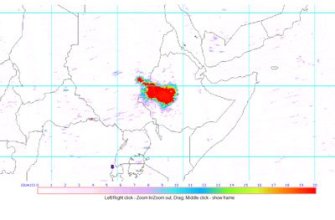New eruption in Ethiopia!
Three days ago, I received an email from Eruptions reader Gijs de Reijke who was curious about something he noticed in the daily OMI SO2 images:

OMI sulfur dioxide map over Ethiopia for June 30, 2009.
Now, I wasn’t quite sure what to make of it other than the fact that there was an awful lot of sulfur dioxide in the vicinity of Addis Ababa, which seemed odd. If we look at a map of the active volcanoes in Ethiopia (below), a majority of the ones we might suspect if the SO2 was volcano are to the north (Erte Ale, Dallafilla), but this patch is smack-dab in the middle of the country, looking like it could be coming from the Great Rift Valley rather than the usual northern suspect. So, I was a little baffled and told Gijs I wasn’t sure what was happening.

Volcanoes of Ethiopia and northwestern Africa
Well, the question is answered. This morning there was this report on the Volcano List (from Simon Carn of OMI Research Group):
There appears to have been another effusive eruption in the
Karbahi – Manda Hararo region of Afar. There was a MODIS thermal anomaly
indicating surface lava flows. Preliminary analysis (based on SO2
emissions) suggests that it is larger than the Manda Hararo eruption in
August 2007, but not as large as the Alu-Dalaffilla eruption last
November. I haven’t heard of any visual confirmation of the eruption
from the ground yet.”
Manda Hararo! This is a basaltic shield volcano that is, in fact, in the north of the the country (for reference, it is just to the northwest of Ardoukoba inside Ethiopia), and was previously not believed to be very active – mostly because there were few eye witness reports of lava flows from the volcano historically. However, this is the second eruption from Manda Hararo in the last two years (the last was in August 2007), both lava flow (effusive) eruption (and both spotted by the satellite, either by MODIS or OMI). The eruption in 2007 did prompt evacuations (and 5 deaths) of the sparsely populated area near the volcano.
There have also been thermal anomalies that have been detected by MODIS:
Manda-Hararo (40.8E, 12.2N; degrees and decimal degrees) show a series
of alerts spread over considerable area for as late as 30 June 2009.
Going back in time, there appeared a large intense cluster (29 June), a
less intense cluster (28-27 June), and then no hits on earlier days.
So, it seems that the eruption might have initiated around June 27th and was most intense (so far) on June 30, when Gijs spotted the sulfur dioxide anomaly over Ethiopia. There have been no eye witness reports of this new activity at Manda Hararo, but it could be expected that this eruption is very similar to that in 2007, so mostly basaltic lava flows (below) that are dangerous when people are caught unprepared to evacuate. Also, there might be significant volcanic gases such as sulfur dioxide and carbon dioxide that could pose a threat to people if they breathe them. Hopefully we’ll have some reports from the ground about the activity soon.

Manda Hararo lava flow in 2007. Image courtesy of the GVP.




